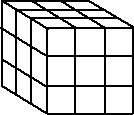Since vectors can be thought of as a 1 x n array of elements, and a matrix is an n x m array of elements, then why not continue this sequence to mathematical objects with n x m x p elements and n x m x p ...

What would be the multiplication rules for such an algebra?
I can't think of an application for this (unless it is the same as a tensor?) in which case it is used extensively in electromagnetic fields, relativity, quantum mechanics and particle physics.
Could it be, for instance, by analogy with a linear equation, where a matrix transforms on vector into another:
|
= |
|
|
that a hypermatrix might transform one matrix into another (multi-linear algebra?):
|
= |  |
|
Of course we can transform a 3x3 matrix into another 3x3 matrix by multiplying it by a third 3x3 matrix. Would it be more general to multiply it by a hypermatrix?
Or is it possible to have a matrix equivalent of multivectors (Clifford algebra) with two types of multiplication. An inner product which transforms:
real number <-- vector <--- matrix <-- hypermatrix
and an outer product which transforms:
real number --> vector ---> matrix --> hypermatrix
What is the relationship between a hypermatrix and a tensor?
Is a hypermatrix just a representation of a tensor?
I think that perhaps a tensor must be square, cuboid, ... In other words it must be the same size in each dimention?
So perhaps not all hypermatrices are tensors?
| Rank | representation | element notation |
|---|---|---|
| 0 | scalar | a |
| 1 | vector | ai |
| 2 | matrix | aij |
| 3 | hypermatrix of rank 3 | aijk |

